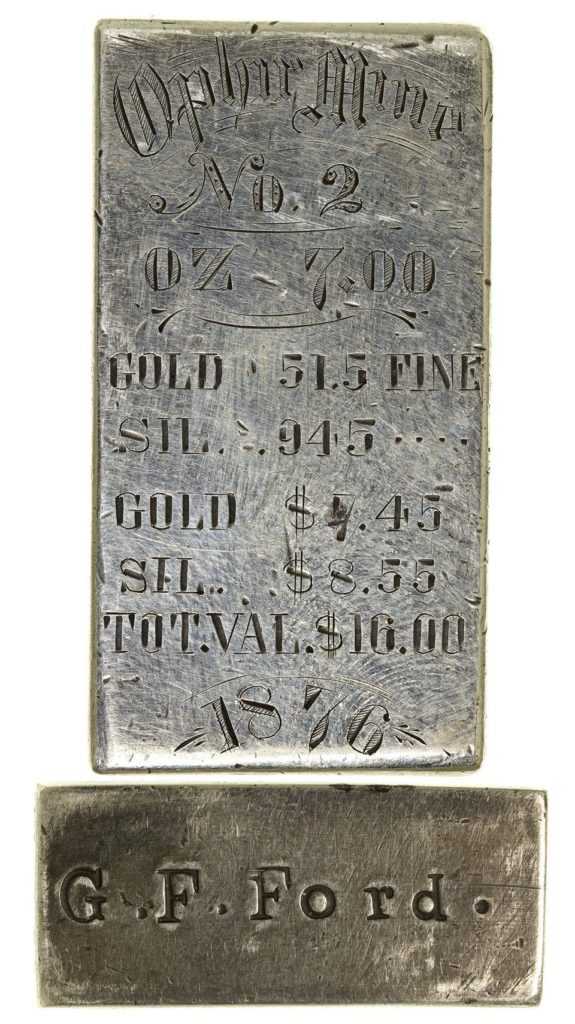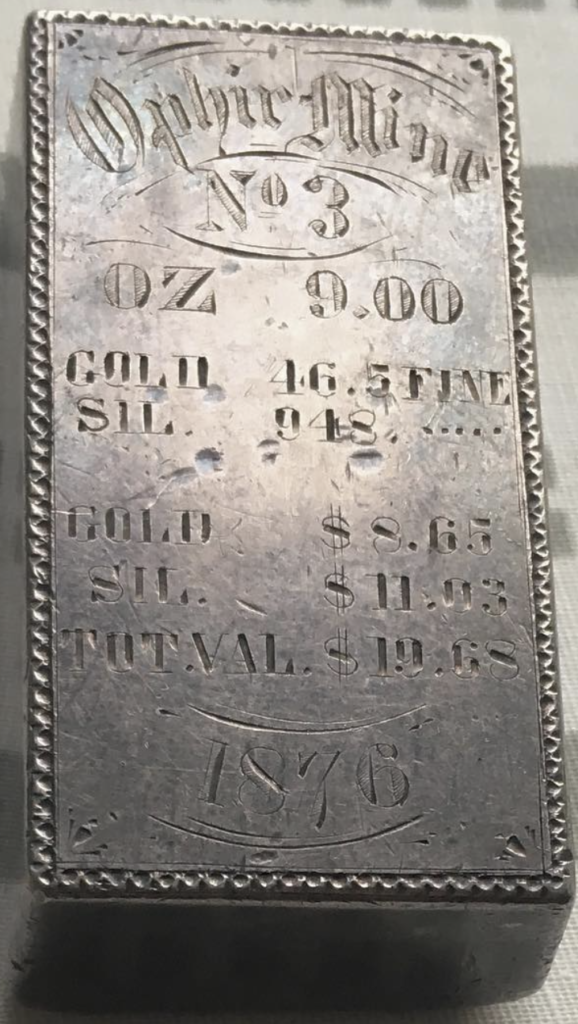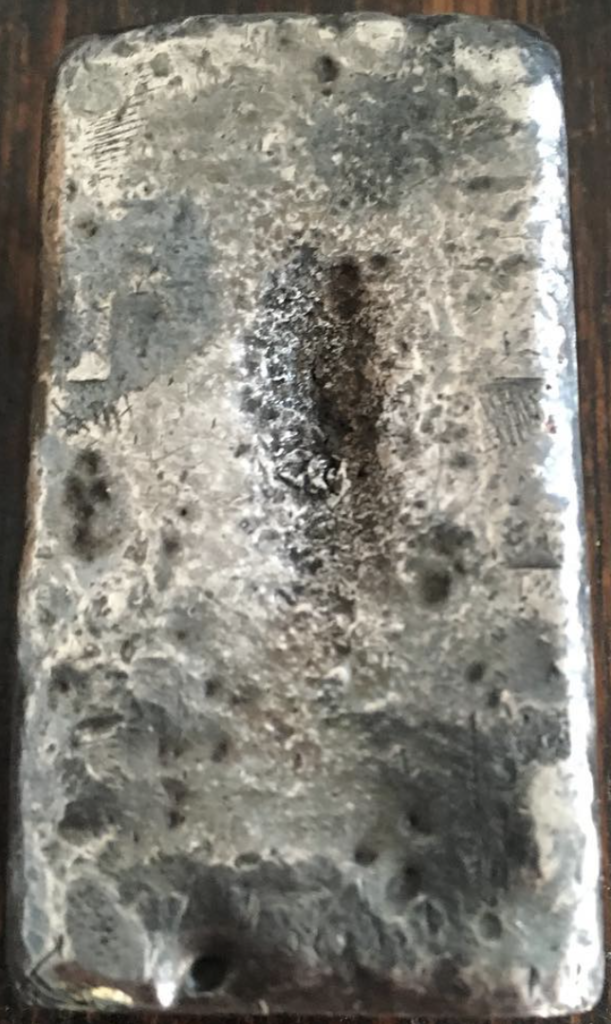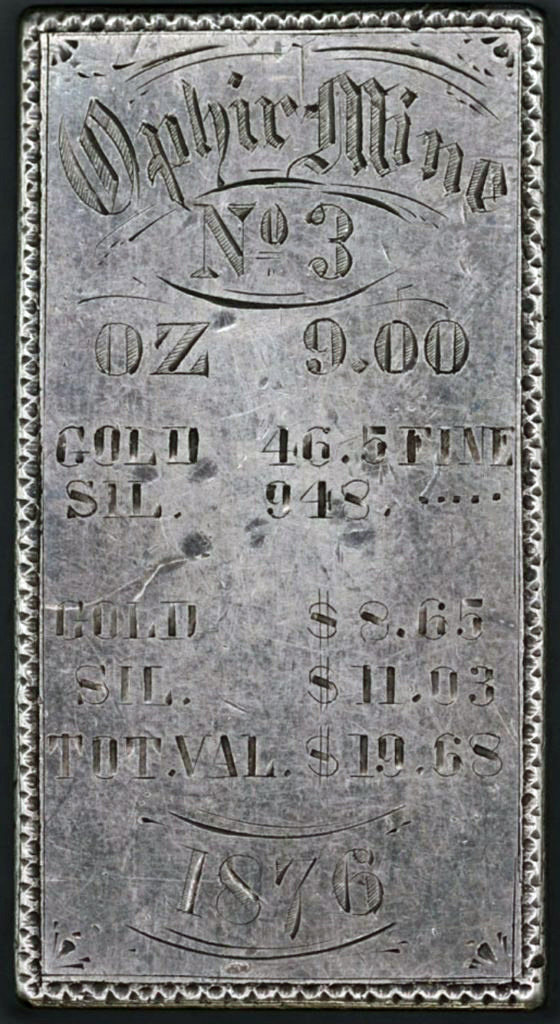This ingot pair came from an estate in the Eastern United States, uncovered this year. We had originally planned on separating the pair, but after research, find the two are inseparable, clearly owned and collected by the same person, George F. Ford. The story of Ford involves his work with important mines on the Comstock, starting as a laborer of various sorts, and his ultimate promotion to a management position with the Ophir mine when the Big Bonanza was found in 1875-6, culminating with his position as secretary of the Virginia & Truckee Railroad. The story is fascinating, with the web of research showing how excited businessmen were with the Comstock mines, especially during peak production.

Ford received two small silver ingots during his lifetime, apparently saved by relatives over the years. The first is about 1 troy ounce, measuring about 1.5” x 1” x ¼”. The second is ornately engraved from the period “Ophir Mine No. 2, 7 ozs, Gold 51.5 fine, silver 945 fine, gold $7.45, silver $8.55, Total $16.00, 1876”. It measures 2” x 1” x ¾”. It is exactly made in the style of an assayer ingot, sans the assayer’s name, though it is clear who made the ingot.
George F. Ford
George F. Ford was born in Boston in 1843. When the Civil War threatened the American way of life, Ford enlisted with Company A, 13th Massachusetts Infantry as a private. Ford fought at Gettysburg, and was captured by the Confederates on the second day of the war (July 2, 1863), housed at Belle Isle, a Confederate prisoner of war camp on the James River in Virginia. The report of the war by his senior officer is interesting: Report of N. Walter Batchelder, 13th Mass, 8/21/1863 to headquarters. July 1, engaged at Gettysburg. “We left the road and moved out to the front of Gettysburg, and soon came under fire of the enemy. The enemy, so far outnumbering us, our brigade was sent into action by regiments, and with so great an interval between my regiment and the one on my left that we were not able to properly support each other…Col. Leonard was wounded early…and the command devolved upon me.” That first day, Batchelder’s men captured 132 prisoners including 7 officers, but did not report the number of Union soldiers captured during the five day war, of which Ford was one. It was thought that Union forces were no more than 15,000 men facing 50,000 Confederates, hence the report of being outnumbered. Ford was released sometime later in a prisoner exchange. He remained active until discharged August 1, 1864.
Ford Reaches the Comstock, 1866
After a brief stint at home in Massachusetts, Ford heard the great news of the Comstock, and set out for Nevada. Once in Virginia City, he was hired by the Savage Mine as a fireman, a position he held for at least three years.
The first of the two silver ingots is dated 1868, and carries Ford’s name on the obverse, and the initials of another (“H.B.T.”) on one end. I believe these are the initials of a friend that worked for the Savage, though I can find no such initials in any of the directories of the period (Gillis, 1868 and Crocker 1871), or it could be the initials of a female suitor, who may have given Ford the ingot in remembrance. My current thought is that it was given to Ford by a friend to commemorate his time with the Savage Mine.
Ford and the Ophir Mine
About 1869, Ford took a position with the Ophir Mine as a clerk, perhaps keeping track of daily transactions inclusive of payroll. The importance of his position grew with the years, as the Big Bonanza was discovered about 1875 in the Con-Virginia and California. The year 1875 was a major year for the Ophir and the other two key Comstock mines. With it began a four year period of the richest production in Comstock history, averaging nearly $30 million per year, as reported by Couch and Carpenter, which severely underreported the bullion reports of the specific companies for an unknown reason.
The Engineering and Mining Journal reported in 1875 that production at the Ophir was at an all time high until the horrific fire of October 26, 1875, when the entire Ophir mine works were destroyed. Superintendant Sam Curtis, a long time Comstock mine super who worked for the Gould & Curry during their boom years, ran the operation, and reported that he tried to save some of the works by blowing up some of the buildings so the fire wouldn’t consume them, thus preserving the equipment. It didn’t work, and the fire consumed everything, melting every ounce of metal. The Company had spent $300,000 upgrading the shaft equipment in preparation for a huge push at increased mining to attack the high grade ores they had just encountered prior to the fire. Curtis reported: “I blew up several buildings with Giant powder around the works in hopes of saving them, but all efforts were futile.” (Raymond, Mines and Mineral Resources West of the Rocky Mountains, 1877, p148) Insured for only $60,000, the works were a total loss.
The grades of ore mined in 1875 were so high that the output of metal was twice the normal value per ton on average. The Engineering and Mining Journal reported January 1, 1876 that pre-bonanza, the ore averaged $26.94/ton in recovered metals. After discovery, the average yield in all of 1875 was $58.54/ton, nearly three ounces of gold per ton equivalent, which shows just how rich the ore was. The mine was producing 150 to 300 tons per day, attempting to average a bit over 200 tons per day. In 1863, the Ophir produced $1.514 million. In 1875, it produced $1.817 million, its best production ever.
With the discovery of the bonanza ores in 1875, the second Ophir shaft was deepened. At 1450 feet in mid 1875, they strove to reach 2000 feet by 1876, and reported plans to deepened the shaft to 4,000 feet, as reported in DeQuille’s Big Bonanza, 1876. The bonanza ore body was 600 feet deep and perhaps 1000 feet across. It existed mainly in the Con-Virginia and California, but also crossed into the Ophir ground. In February,1876, the company reported that they were driving toward the top of “the bonanza ore body.” Their April production was $211,000, May $120,000 and June it was noted that they had struck a wide zone of low grade ore. Meanwhile, the second Ophir shaft was being deepened daily.
The first Ophir shaft was developed in 1859 and sunk to over 750 feet by the end of 1860. An original pen on linen cross section of the Ophir shaft was in the collection of Bob Kendall, who, with his father operated a small open pit mine on the Ophir near-surface ore in circa 1948-52. By the late 1860’s, it was evident that a second shaft was needed to attack deeper ores. It is my belief, that following mining custom, the second shaft became known as “Ophir No. 2”. In reports printed by Raymond in 1876, it was also known as “Buck’s Shaft,” though that name is not readily found in any other literature.
Ford’s work with the Ophir during 1875-6 was critically important. The boom in production, coupled with the huge increase in equipment used to deepen the second shaft, all greatly curtailed by the Fire of October, 1875, placed his job in even greater importance. In early 1876, when the works were re-erected and serious mining could begin anew, the workers and management certainly must have celebrated. The second silver ingot of Ford’s commemorates the reopening of the second Ophir Shaft, Ophir No. 2, and the reawakening of production of the bonanza ore. Ford may have received this in late 1876.
The Ophir ingot was made in the exact style of typical assayer ingots. Though it does not have the assayer’s names on the ingot, it is clearly made by Clarence Sharon and John West, the two assayers at the Ophir Mine listed in Bethel’s 1875 Directory (pages 137,157).
Ford Moves to The Virginia & Truckee Railroad
Ford joined forces with Hume Yerington in 1878 as the secretary of the Virginia & Truckee Railroad. His strong clerking abilities were much needed by Yerington, and Ford embraced the position. He moved to Carson City, and kept his office there. Curiously, Ford is not found in the Bishop Directory of 1878, indicating he was possibly relocating after taking the job from the V&T RR. Ford had been an active Mason in Virginia City, there for the opening of the lodge, and also acting as secretary. But the 1878 Directory doesn’t show him as a resident of member of any of the Masons lodges that year. Ford also belonged to the G.A.R. He apparently was single all of his life and once said of himself that he was the only man in Carson (City) who never meddled with other people’s business.” (Obit, Morning Appeal, 4/1/1898). Ford died of a heart attack in March 1898 at the age of 55. His burial and funeral procession was a somber grand event by the G.A.R. and Masons (KT) in full uniform.
Additional Notes
The Ophir Mine No. 2 silver ingot is the second Ophir mine ingot known, though both are considerably different. The two ingots were kept in a small tin “Edgeworth High Grade Tobacco” box that appears to date to the approximate time of Ford’s death in 1898. It comes with this lot.
[07/2011] https://www.icollector.com/NV-Virginia-City-Storey-County-1868-1876-Ophir-and-Savage-Silver-Ingots-and-George-F-Ford_i10679689 ($25,850)
9.00 oz Ophir Mine, 1876 Dated, Face Value: $19.68


The bar was made at the 1876 International Exhibition of Arts, Manufactures and Products of Soil and MIne in Philiadelphia (technically the first World’s Fair) where mines brought ore and fabricated ingots at the fair. The Ophir claim was the first major mine of the Comstock Lode and one of the most profitable mines in history.
The Ophir ingots have an engraving style that is very similar to the Beale which is also dated 1876. Similarly, the silver purity is almost identical as well and appears to be from the same region.
Another more direct angle can be seen below.

This 1876 Virginia City, Storey County, Nev., silver ingot produced by The Ophir Mine is a stunning example of a classic old western ingot. Probably the best-known example of an Ophir Mine piece with its beautifully engraved front displaying very little wear and impeccable details without the brownish blemish over the number 7 the other example has. This bar market Number 3 “No 3”, weight is 9 ozs with Gold 46.5 FINE and Silver 948. To date there are only two known examples of a surviving Ophir Mine Ingot with rumors of a third existing although we haven’t seen it yet.
